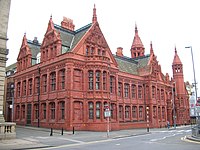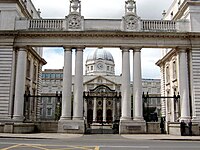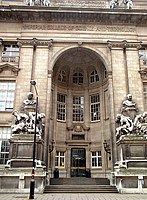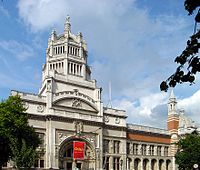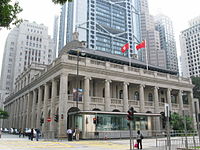199.198.251.107 (talk) No edit summary |
Changed image to better quality version, added authority control and honours, formatting |
||
| Line 2: | Line 2: | ||
{{Infobox architect |
{{Infobox architect |
||
|name = Sir Aston Webb |
|name = Sir Aston Webb |
||
|image = Aston Webb.jpg |
|image = Sir Aston Webb by Solomon Joseph Solomon.jpg |
||
| ⚫ | |||
|caption = |
|||
| ⚫ | |||
|nationality = English |
|nationality = English |
||
|birth_date = {{birth date|1849|05|22|df=yes}} |
|birth_date = {{birth date|1849|05|22|df=yes}} |
||
| Line 14: | Line 13: | ||
|significant_projects = |
|significant_projects = |
||
|significant_design = |
|significant_design = |
||
|awards = {{plainlist| |
|||
|awards = {{no wrap|Knighted <small>(1904)</small><br>[[Royal Gold Medal]] for Architecture <small>(1905)</small><br>[[American Institute of Architects]] [[AIA Gold Medal|Gold Medal]] <small>(1907)</small><br>[[Albert Medal (Royal Society of Arts)|Albert Medal]] {{small|(1927)}}}} |
|||
* [[Royal Institute of British Architects|RIBA]] [[Royal Gold Medal]] {{small|(1905)}} |
|||
* [[American Institute of Architects|AIA]] [[AIA Gold Medal|Gold Medal]] {{small|(1907)}} |
|||
* [[Royal Society of Arts|RSA]] [[Albert Medal (Royal Society of Arts)|Albert Medal]] {{small|(1927)}} }} |
|||
}} |
}} |
||
| ⚫ | '''Sir Aston Webb''', [[Knight Grand Cross of the Royal Victorian Order|GCVO]], [[Companion of the Order of the Bath|CB]], [[President of the Royal Academy|PRA]], [[Royal Institute of British Architects|FRIBA]] (22 May 1849 – 21 August 1930) was an [[England|English]] [[architect]], active in the late 19th century and at the beginning of the 20th century. He was President of the [[Royal Academy]] from 1919 to 1924, and the founding Chairman of the [[London Society (organisation)|London Society]], from 1912. |
||
'''Sir Aston Webb''', [[Royal Academy|PRA]], [[Royal Institute of British Architects|FRIBA]] (22 May 1849<ref>{{cite web |url= http://search.ancestry.co.uk/cgi-bin/sse.dll?db=uki1881&rank=1&new=1&so=3&MSAV=0&msT=1&gss=ms_db-7572&gsfn=aston+&gsln=webb&_81004010=1849&msbpn__ftp=clapham&msrpn__ftp=kensington&dbOnly=_F00027B9%7C_F00027B9_x&dbOnly=_83004006%7C_83004006_x |title= Ancestry.com. 1881 England census |accessdate=11 May 2009 |author= The National Archives of the UK (TNA): Public Record Office (PRO) |year= 1881 |work= 1881 England census |publisher= |pages= Class: RG11 Piece: 30; Folio: 72; Page: 29, 13 Lansdowne Crescent Kensington }}</ref> - 21 August 1930<ref>{{cite web |
|||
|url= http://freebmd.rootsweb.com/cgi/information.pl?r=160234354&d=bmd_1240397075 |
|||
| ⚫ | |||
| ⚫ | |||
==Life== |
==Life== |
||
The son of a water-colour painter (and former pupil of landscape artist [[David Cox (artist)|David Cox]]), [[Edward Webb]], Aston Webb was born in [[Clapham]], London, and received his initial architectural training articled in the firm of [[Robert Richardson Banks|Banks]] and [[Charles Barry (junior)|Barry]] from 1866 to 1871, after which he spent a year travelling in Europe and Asia. He returned to London in 1874 to set up his own practice. |
The son of a water-colour painter (and former pupil of landscape artist [[David Cox (artist)|David Cox]]), [[Edward Webb]], Aston Webb was born in [[Clapham]], London, on 22 May 1849<ref>{{cite web |url= http://search.ancestry.co.uk/cgi-bin/sse.dll?db=uki1881&rank=1&new=1&so=3&MSAV=0&msT=1&gss=ms_db-7572&gsfn=aston+&gsln=webb&_81004010=1849&msbpn__ftp=clapham&msrpn__ftp=kensington&dbOnly=_F00027B9%7C_F00027B9_x&dbOnly=_83004006%7C_83004006_x |title= Ancestry.com. 1881 England census |accessdate=11 May 2009 |author= The National Archives of the UK (TNA): Public Record Office (PRO) |year= 1881 |work= 1881 England census |publisher= |pages= Class: RG11 Piece: 30; Folio: 72; Page: 29, 13 Lansdowne Crescent Kensington }}</ref> and received his initial architectural training articled in the firm of [[Robert Richardson Banks|Banks]] and [[Charles Barry (junior)|Barry]] from 1866 to 1871, after which he spent a year travelling in Europe and Asia. He returned to London in 1874 to set up his own practice. |
||
From the early 1880s, he joined the [[Royal Institute of British Architects]] (1883) and began working in partnership with [[Ingress Bell]] (1836–1914). Their first major commission was a winning design for the [[Victoria Law Courts, Birmingham|Victoria Law Courts]] in [[Birmingham]] (1886), the first of numerous public building schemes the pair designed over the next 23 years. Towards the end of his career Webb was assisted by his sons, [[Maurice Webb (architect)|Maurice]] and [[Philip Edward Webb|Philip]]. [[Ralph Knott]], who designed London's [[County Hall, London|County Hall]], began his work as an apprentice to Webb executing the drawings for his competition entries. |
From the early 1880s, he joined the [[Royal Institute of British Architects]] (1883) and began working in partnership with [[Ingress Bell]] (1836–1914). Their first major commission was a winning design for the [[Victoria Law Courts, Birmingham|Victoria Law Courts]] in [[Birmingham]] (1886), the first of numerous public building schemes the pair designed over the next 23 years. Towards the end of his career Webb was assisted by his sons, [[Maurice Webb (architect)|Maurice]] and [[Philip Edward Webb|Philip]]. [[Ralph Knott]], who designed London's [[County Hall, London|County Hall]], began his work as an apprentice to Webb executing the drawings for his competition entries. |
||
| ⚫ | He died in [[Kensington]], London, on 21 August 1930.<ref>{{cite web|url= http://freebmd.rootsweb.com/cgi/information.pl?r=160234354&d=bmd_1240397075|title= Index of Death of Aston Webb |accessdate=11 May 2009 |work= [[FreeBMD]] |publisher= [[General Register Office of England and Wales]] |quote= Deaths Sep 1914, Webb, Aston, 81, Kensington, 1a 173}}</ref> |
||
| ⚫ | He served as RIBA President (1902–1904) and, having been elected as a full member of the Royal Academy in 1903, served as acting president from 1919 to 1924. He |
||
===Honours and awards=== |
|||
| ⚫ | He served as RIBA President (1902–1904) and, having been elected as a full member of the Royal Academy in 1903, served as acting president from 1919 to 1924. He received the [[Royal Gold Medal]] for Architecture in 1905 and was the first recipient of the [[American Institute of Architects]] [[AIA Gold Medal|Gold Medal]] in 1907. He was the first chairman of the [[London Society (organisation)|London Society]] in 1912.<ref>http://www.londonsocietyjournal.org.uk/</ref> |
||
He was [[Knight Bachelor|knighted]] in 1904,<ref>{{cite journal|title=Webb, Sir Aston|journal=Who's Who,|year=1907|volume= 59|pages=p. 1856|url=http://books.google.com/books?id=yEcuAAAAYAAJ&pg=PA1856}}</ref><ref>{{London Gazette|issue=27745|startpage=8718|endpage=8719|date=20 December 1904}}</ref> appointed a Commander of the [[Order of the Bath]] in 1909;<ref>{{London Gazette|city=e|issue=12156|startpage=714|date=2 July 1909}}</ref> and appointed to the [[Royal Victorian Order]] as Commander in 1911, promoted to Knight Commander in 1914 and Knight Grand Cross in 1925.<ref>{{London Gazette|issue=28496|startpage=3816|date=19 May 1911}}</ref><ref>{{London Gazette|city=e|issue=12630|startpage=9|endpage=10|date=2 January 1914}}</ref><ref>{{London Gazette|issue=33007|supp=yes|startpage=5|date=30 December 1924}}</ref> |
|||
==Works== |
==Works== |
||
[[File:Aston Webb building, part of Imperial College London, spring 2013.jpg|thumb |
[[File:Aston Webb building, part of Imperial College London, spring 2013.jpg|thumb|Imperial College London]] |
||
[[File:Buckingham palace and Victoria memorial.jpg|thumb |
[[File:Buckingham palace and Victoria memorial.jpg|thumb|Buckingham palace and Victoria memorial]] |
||
[[File:1911 Britannica-Architecture-Master’s House.png|thumb |
[[File:1911 Britannica-Architecture-Master’s House.png|thumb|A drawing showing Plan of a Master's House, New Christ's Hospital (Webb and Bell).]] |
||
One of his earliest works was built for the [[Six Masters]] of The [[Royal Grammar School Worcester]] in 1877. These [[almshouse]]s are in the [[Arts and Crafts]] style, different from his later work. |
One of his earliest works was built for the [[Six Masters]] of The [[Royal Grammar School Worcester]] in 1877. These [[almshouse]]s are in the [[Arts and Crafts]] style, different from his later work. |
||
| Line 39: | Line 43: | ||
Webb also designed the [[Victoria and Albert Museum]]'s main building (designed 1891, opened 1909), the [[Royal United Services Institute]], [[Whitehall]] (1893–95) and – as part of The Mall scheme – [[Admiralty Arch]] (1908–09). He also designed the [[Britannia Royal Naval College]], Devon, where Royal Naval officers are still trained. He enlarged and sympathetically restored the perpendicular Church of St John Baptist, [[Claines]], Worcester, finishing in 1886. Nearby he was also responsible for the new church of St. George, consecrated in 1895, which replaced an earlier smaller building in St. George's Square, Barbourne, Worcester. With his partner [[Ingress Bell]], he extended St Andrew's Church, Fulham Fields (London), remodelled the chancel and built the Lady Chapel. |
Webb also designed the [[Victoria and Albert Museum]]'s main building (designed 1891, opened 1909), the [[Royal United Services Institute]], [[Whitehall]] (1893–95) and – as part of The Mall scheme – [[Admiralty Arch]] (1908–09). He also designed the [[Britannia Royal Naval College]], Devon, where Royal Naval officers are still trained. He enlarged and sympathetically restored the perpendicular Church of St John Baptist, [[Claines]], Worcester, finishing in 1886. Nearby he was also responsible for the new church of St. George, consecrated in 1895, which replaced an earlier smaller building in St. George's Square, Barbourne, Worcester. With his partner [[Ingress Bell]], he extended St Andrew's Church, Fulham Fields (London), remodelled the chancel and built the Lady Chapel. |
||
Other educational commissions included the new buildings of [[Christ's Hospital]] in [[Horsham]], Sussex (1893–1902), the [[Royal College of Science]], [[South Kensington]] (1900–06), [[King's College, Cambridge]] (1908), the [[Royal School of Mines]], South Kensington (1909–13), [[Royal Russell School]], [[Coombe, Croydon]], [[Surrey]] and the [[Royal College of Science for Ireland]] which now houses the [[Government Buildings|Irish Government Buildings]]. |
Other educational commissions included the new buildings of [[Christ's Hospital]] in [[Horsham]], Sussex (1893–1902), the [[Royal College of Science]], [[South Kensington]] (1900–06), [[King's College, Cambridge]] (1908), the [[Royal School of Mines]], South Kensington (1909–13), [[Royal Russell School]], [[Coombe, Croydon]], [[Surrey]] and the [[Royal College of Science for Ireland]] which now houses the [[Government Buildings|Irish Government Buildings]]. |
||
Residential commissions included Nos 2 (''The Gables'') and 4 (''Windermere'') Blackheath Park, in [[Blackheath, London|Blackheath]], south-east London. He also designed (1895–96) a library wing, including the Cedar Library, at [[The Hendre]], a large Victorian mansion in Monmouthshire, for John Allan Rolls, first Lord Llangattock. |
Residential commissions included Nos 2 (''The Gables'') and 4 (''Windermere'') Blackheath Park, in [[Blackheath, London|Blackheath]], south-east London. He also designed (1895–96) a library wing, including the Cedar Library, at [[The Hendre]], a large Victorian mansion in Monmouthshire, for John Allan Rolls, first Lord Llangattock. |
||
In March 1889, the [[Consistory (Protestantism)#Reformed usage|consistory]] of the [[French Protestant Church of London]] commissioned (Sir) Aston Webb to design a new church.<ref>[http://www.british-history.ac.uk/report.aspx?compid=41034 French Protestant Church of London]</ref> It was erected in 1891–93 at 8–9 Soho Square in London. The church is one of Aston Webb's Gothic school works. |
In March 1889, the [[Consistory (Protestantism)#Reformed usage|consistory]] of the [[French Protestant Church of London]] commissioned (Sir) Aston Webb to design a new church.<ref>[http://www.british-history.ac.uk/report.aspx?compid=41034 French Protestant Church of London]</ref> It was erected in 1891–93 at 8–9 Soho Square in London. The church is one of Aston Webb's Gothic school works. |
||
| Line 50: | Line 52: | ||
In 1901, Aston Webb designed the headquarters for a brewery at 115 Tooley Street, London, recently converted into 14 apartments as "Aston Webb House". This was done as part of the development of [[More London]]. |
In 1901, Aston Webb designed the headquarters for a brewery at 115 Tooley Street, London, recently converted into 14 apartments as "Aston Webb House". This was done as part of the development of [[More London]]. |
||
[[Weetman Pearson, 1st Viscount Cowdray]] commissioned Webb to undertake major extensions to his property, [[Dunecht House]], [[Aberdeenshire]], which were carried out {{circa}} 1913–20.<ref name=HS3133> |
[[Weetman Pearson, 1st Viscount Cowdray]] commissioned Webb to undertake major extensions to his property, [[Dunecht House]], [[Aberdeenshire]], which were carried out {{circa}} 1913–20.<ref name=HS3133>{{cite web |url=http://data.historic-scotland.gov.uk/pls/htmldb/f?p=2200:15:0::::BUILDING,HL:3133,Dunecht%20House |title=Dunecht House: Listed Building Report |publisher=Historic Scotland}} |
||
{{cite web |url=http://data.historic-scotland.gov.uk/pls/htmldb/f?p=2200:15:0::::BUILDING,HL:3133,Dunecht%20House |title=Dunecht House: Listed Building Report |publisher=Historic Scotland}} |
|||
</ref> |
</ref> |
||
| Line 58: | Line 59: | ||
==Gallery of architectural work== |
==Gallery of architectural work== |
||
<gallery widths="200px" heights="200px |
<gallery widths="200px" heights="200px"> |
||
File:Admiralty Arch - 01.jpg|Admiralty Arch, The Mall, London |
File:Admiralty Arch - 01.jpg|Admiralty Arch, The Mall, London |
||
File:Victoria Law Courts Birmingham.jpg|Victoria Law Courts, Birmingham |
File:Victoria Law Courts Birmingham.jpg|Victoria Law Courts, Birmingham |
||
| Line 79: | Line 80: | ||
File:Buckingham Palace from gardens, London, UK - Diliff.jpg|Buckingham Palace. This is the principal [[Facade|façade]], the East Front; originally constructed by [[Edward Blore]] and completed in 1850, it was redesigned in 1913 by Sir Aston Webb. |
File:Buckingham Palace from gardens, London, UK - Diliff.jpg|Buckingham Palace. This is the principal [[Facade|façade]], the East Front; originally constructed by [[Edward Blore]] and completed in 1850, it was redesigned in 1913 by Sir Aston Webb. |
||
File:Royal School of Mines entrance.jpg|[[Royal School of Mines]], [[Imperial College]], London |
File:Royal School of Mines entrance.jpg|[[Royal School of Mines]], [[Imperial College]], London |
||
| ⚫ | |||
| ⚫ | |||
</gallery> |
</gallery> |
||
| ⚫ | |||
| ⚫ | |||
==Notes== |
==Notes== |
||
| Line 99: | Line 97: | ||
{{s-culture}} |
{{s-culture}} |
||
{{s-bef |before=[[Edward Poynter|Sir Edward Poynter, Bt]]}} |
{{s-bef |before=[[Edward Poynter|Sir Edward Poynter, Bt]]}} |
||
{{s-ttl |title=[[ |
{{s-ttl |title=[[President of the Royal Academy]] |years=1919–1924}} |
||
{{s-aft |after=[[Frank Dicksee]]}} |
{{s-aft |after=[[Frank Dicksee]]}} |
||
{{s-end}} |
{{s-end}} |
||
{{Authority control}} |
|||
{{Persondata <!-- Metadata: see [[Wikipedia:Persondata]]. --> |
{{Persondata <!-- Metadata: see [[Wikipedia:Persondata]]. --> |
||
| Line 119: | Line 119: | ||
[[Category:People associated with Imperial College London]] |
[[Category:People associated with Imperial College London]] |
||
[[Category:Knights Bachelor]] |
[[Category:Knights Bachelor]] |
||
[[Category:Knights Grand Cross of the Royal Victorian Order]] |
|||
[[Category:Companions of the Order of the Bath]] |
|||
[[Category:Artists' Rifles soldiers]] |
[[Category:Artists' Rifles soldiers]] |
||
[[Category:Fellows of the Royal Institute of British Architects]] |
[[Category:Fellows of the Royal Institute of British Architects]] |
||
Revision as of 15:56, 31 December 2014
Sir Aston Webb | |
|---|---|
 Sir Aston Webb, portrait by Solomon Joseph Solomon, c. 1906 | |
| Born | 22 May 1849 |
| Died | 21 August 1930 (aged 81) |
| Nationality | English |
| Occupation | Architect |
| Awards |
|
| Buildings | University of Birmingham |
Sir Aston Webb, GCVO, CB, PRA, FRIBA (22 May 1849 – 21 August 1930) was an English architect, active in the late 19th century and at the beginning of the 20th century. He was President of the Royal Academy from 1919 to 1924, and the founding Chairman of the London Society, from 1912.
Life
The son of a water-colour painter (and former pupil of landscape artist David Cox), Edward Webb, Aston Webb was born in Clapham, London, on 22 May 1849[1] and received his initial architectural training articled in the firm of Banks and Barry from 1866 to 1871, after which he spent a year travelling in Europe and Asia. He returned to London in 1874 to set up his own practice.
From the early 1880s, he joined the Royal Institute of British Architects (1883) and began working in partnership with Ingress Bell (1836–1914). Their first major commission was a winning design for the Victoria Law Courts in Birmingham (1886), the first of numerous public building schemes the pair designed over the next 23 years. Towards the end of his career Webb was assisted by his sons, Maurice and Philip. Ralph Knott, who designed London's County Hall, began his work as an apprentice to Webb executing the drawings for his competition entries.
He died in Kensington, London, on 21 August 1930.[2]
Honours and awards
He served as RIBA President (1902–1904) and, having been elected as a full member of the Royal Academy in 1903, served as acting president from 1919 to 1924. He received the Royal Gold Medal for Architecture in 1905 and was the first recipient of the American Institute of Architects Gold Medal in 1907. He was the first chairman of the London Society in 1912.[3]
He was knighted in 1904,[4][5] appointed a Commander of the Order of the Bath in 1909;[6] and appointed to the Royal Victorian Order as Commander in 1911, promoted to Knight Commander in 1914 and Knight Grand Cross in 1925.[7][8][9]
Works



One of his earliest works was built for the Six Masters of The Royal Grammar School Worcester in 1877. These almshouses are in the Arts and Crafts style, different from his later work.
Webb's first major work was the restoration of the medieval St Bartholomew-the-Great in Smithfield, London. His brother Edward Alfred Webb was the churchwarden at the time, and his association with the church probably helped the young architect get the job.[10] In London, Webb's best known works include the Queen Victoria Memorial and The Mall approach to, and the principal facade of, Buckingham Palace, which he re-designed in 1913.
Webb also designed the Victoria and Albert Museum's main building (designed 1891, opened 1909), the Royal United Services Institute, Whitehall (1893–95) and – as part of The Mall scheme – Admiralty Arch (1908–09). He also designed the Britannia Royal Naval College, Devon, where Royal Naval officers are still trained. He enlarged and sympathetically restored the perpendicular Church of St John Baptist, Claines, Worcester, finishing in 1886. Nearby he was also responsible for the new church of St. George, consecrated in 1895, which replaced an earlier smaller building in St. George's Square, Barbourne, Worcester. With his partner Ingress Bell, he extended St Andrew's Church, Fulham Fields (London), remodelled the chancel and built the Lady Chapel.
Other educational commissions included the new buildings of Christ's Hospital in Horsham, Sussex (1893–1902), the Royal College of Science, South Kensington (1900–06), King's College, Cambridge (1908), the Royal School of Mines, South Kensington (1909–13), Royal Russell School, Coombe, Croydon, Surrey and the Royal College of Science for Ireland which now houses the Irish Government Buildings.
Residential commissions included Nos 2 (The Gables) and 4 (Windermere) Blackheath Park, in Blackheath, south-east London. He also designed (1895–96) a library wing, including the Cedar Library, at The Hendre, a large Victorian mansion in Monmouthshire, for John Allan Rolls, first Lord Llangattock.
In March 1889, the consistory of the French Protestant Church of London commissioned (Sir) Aston Webb to design a new church.[11] It was erected in 1891–93 at 8–9 Soho Square in London. The church is one of Aston Webb's Gothic school works.
In 1901, Aston Webb designed the headquarters for a brewery at 115 Tooley Street, London, recently converted into 14 apartments as "Aston Webb House". This was done as part of the development of More London.
Weetman Pearson, 1st Viscount Cowdray commissioned Webb to undertake major extensions to his property, Dunecht House, Aberdeenshire, which were carried out c. 1913–20.[12]
The central building of Chancellor's Court at the University of Birmingham, UK was designed by Webb and Ingress Bell and named after Aston Webb. It includes the Great Hall. The main feature is a large dome that sits atop the building.
Gallery of architectural work
-
Admiralty Arch, The Mall, London
-
Victoria Law Courts, Birmingham
-
Government Buildings, Dublin, Ireland
-
Main entrance, Royal School of Mines, South Kensington, London
-
Britannia Royal Naval College, Dartmouth, Devon
-
Main entrance, Victoria and Albert Museum, South Kensington, London
-
The London Troops war memorial, Royal Exchange, sculpture by Alfred Drury
-
Cromwell Gardens Facade, Victoria and Albert Museum, South Kensington, London
-
Aston Webb building, The University of Birmingham
-
Quad, Christ's Hospital in Horsham, West Sussex
-
The Hendre, Monmouthshire, Wales
-
Dunecht House, Aberdeenshire
-
Victoria and Albert Museum
-
The Victoria Memorial, The Mall, London
-
Buckingham Palace. This is the principal façade, the East Front; originally constructed by Edward Blore and completed in 1850, it was redesigned in 1913 by Sir Aston Webb.
-
Royal School of Mines, Imperial College, London
-
Chamber, Former Supreme Court, now Hong Kong Legislative Council Building
-
Former Supreme Court and Hong Kong Legislative Council Building
Notes
- ^ The National Archives of the UK (TNA): Public Record Office (PRO) (1881). "Ancestry.com. 1881 England census". 1881 England census. pp. Class: RG11 Piece: 30, Folio: 72, Page: 29, 13 Lansdowne Crescent Kensington. Retrieved 11 May 2009.
- ^ "Index of Death of Aston Webb". FreeBMD. General Register Office of England and Wales. Retrieved 11 May 2009.
Deaths Sep 1914, Webb, Aston, 81, Kensington, 1a 173
- ^ http://www.londonsocietyjournal.org.uk/
- ^ "Webb, Sir Aston". Who's Who,. 59: p. 1856. 1907.
{{cite journal}}:|pages=has extra text (help)CS1 maint: extra punctuation (link) - ^ "No. 27745". The London Gazette. 20 December 1904.
- ^ "No. 12156". The Edinburgh Gazette. 2 July 1909.
- ^ "No. 28496". The London Gazette. 19 May 1911.
- ^ "No. 12630". The Edinburgh Gazette. 2 January 1914.
- ^ "No. 33007". The London Gazette (invalid
|supp=(help)). 30 December 1924. - ^ Dungavell, The architectural career of Sir Aston Webb (London: University of London, Royal Holloway and New Bedford College), 1999
- ^ French Protestant Church of London
- ^ "Dunecht House: Listed Building Report". Historic Scotland.
External links
- Webb's biography, with emphasis on his work at St. Bartholomew's; includes numerous references
- Claines Church one of Webbs restorations from 1886
- St. George's Church, Barbourne, Worcester by Aston Webb, 1895.
- [1] story of his building at the V&A

